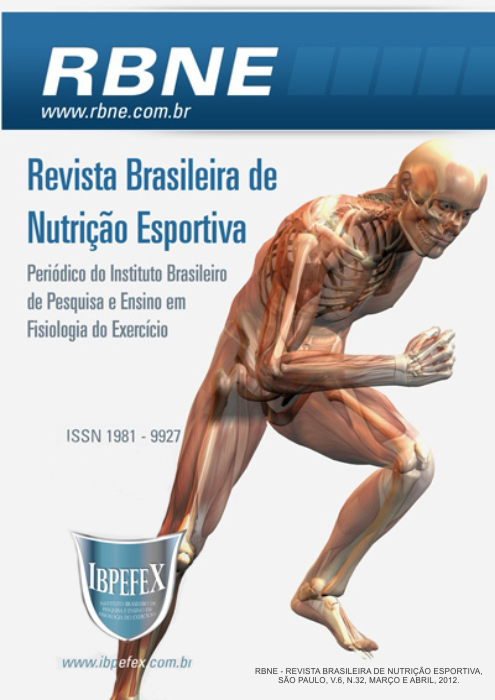Performance assessment and ponderal loss by the carbohydrate intervention in practitioners of Brazilian Jiu Jitsu
Abstract
Introduction: In jiu jitsu exist weight loss due to high dehydrationduring the training. When there is a low in carbohydrate reserves, the ability of the athlete to keep training decreases. Objective: To evaluate the results in an intervention with carbohydrate. Materials and Methods: The study in Ceilândia, DF, in January 2012. We evaluated 12 practicingofjiu jitsu divided into 4 groups. Each group received a type of carbohydrate, water, maltodextrin, brown sugar and banana, respectively. To calculate the average percentage of weight loss of each group was used a formula. To evaluate the performance, was made two tests: push-ups and long jump. Results: There was little variation in weight loss, and compared to other groups, the lowest weight loss was the intervention of water. (0.5%). The best performance in resistance training with push-ups was the intervention with maltodextrin. For muscular strength and power with long jump, the best result was for intervention with brown sugar. Discussion: The results may have been interfered with because of difference infeed of theindividualsand thebetter fitness when compared to others ofthe same study. Conclusion: It is still important the hydration, however, still need more studies to showa better option to use carbohydrates forabetter performance duringthetrainingof jiu jitsu.
References
-Burke, L.; Burke, l.; Deakin, V. Preparation for competition. Clinical Sports Nutrition. Australia: Mc Graw Hill. p. 341-395. 2000.
-Coggan, A. R. Plasma glucose metabolism during exercise: effect of endurance training in humans. Medicine & Science in Sports and Exercise. Vol. 29. Núm. 5. p .620-627, 1997.
-Coyle, E.F.; Coyle, E. Carbohydrates that speed recovery from training. Physician Sports med, 1993.
-Febbraio, M.A.; StewartK. L. CHO feeding before prolonged exercise: effect of glycemic index on muscle glycogenolysis and exercise performance. J Appl Physiol. 1996.
-Franquini, E.; Takito, M. Y.; Pereira, J. N. C. Frequência cardíaca e força de preensão manual durante a luta de jiu jitsu. Revista digital. Ano 9. Núm. 65. 2003.
-Guerra, I.; Leite Neto, T. B. Hidratação e Performance. Revista de nutrição em pauta. Núm. 54, p. 11-13. 2002.
-Manson, W.L.; Mcconell, G.; Hargreaves, M. Carbohydrate ingestion during exercise: liquid vs solid feedings. Medicine and Science in Sports and Exercise, 1993.
-McArdle, W. D.; Katch, F.I.; Katch, V.L. Fisiologia do Exercício: Energia, Nutrição e Desempenho Humano. 3ª edição. Editora Guanabara Koogan.1998.
-Oppliger, R. A.; Case, H. S.; Horswill, C. A.; Landry, G. L.; Shelter, A. C. Redução de peso em lutadores. Revista Brasileira Medicina do Esporte. Vol. 5. Num. 2.1999.
-Poltronieri,R. Treino Quente. Revista Arte Suave. Núm. 6. Ano 2. p 21-22.
-Rossi, L. Nutrição e atividade física: o binômio do século. Nutrição profissional, Vol.1, p.25-30, 2005.
-Sapata, K. B.; Fayh, A. P. T.; Oliveira, A. R. Efeitos de consumo prévio de carboidratos sobre resposta glicêmica e desempenho. Revista brasileira Medicina do Esporte. Vol. 12. Núm. 4.2006.
Authors who publish in this journal agree to the following terms:
- Authors retain the copyright and grant the journal the right of first publication, with work simultaneously licensed under the Creative Commons Attribution License BY-NC which allows the sharing of the work with acknowledgment of the authorship of the work and initial publication in this journal.
- Authors are authorized to enter into additional contracts separately for non-exclusive distribution of the version of the work published in this journal (eg, publishing in institutional repository or book chapter), with acknowledgment of authorship and initial publication in this journal.
- Authors are allowed and encouraged to post and distribute their work online (eg, in institutional repositories or on their personal page) at any point before or during the editorial process, as this can bring about productive change as well as increase impact and impact. citation of published work (See The Effect of Free Access).






